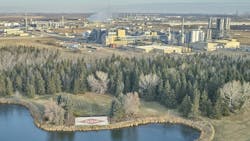Inside Dow’s Plans for a Net-Zero Ethylene Cracker in Canada
Dow took the final steps to building a hydrogen-fueled ethylene facility at its Fort Saskatchewan site in Canada.
The company announced on Nov. 28 its board approved the final investment decision to build the $6.5 billion integrated ethylene cracker and derivatives plant in Alberta. The plant will become the world’s first ethylene cracker to achieve net zero Scope 1 and 2 emissions, the company said.
The project, called Path2Zero, would decarbonize 20% of Dow's global ethylene capacity.
Path2Zero Project Details
The company will begin construction in 2024 by expanding and retrofitting its existing manufacturing site in Fort Saskatchewan. Production will occur in phases, with the first phase starting in 2027, adding approximately 1,285 kilotons per year of ethylene and polyethylene capacity, and the second phase starting up in 2029, adding an additional approximately 600 kilotons per year of capacity.
To achieve net-zero Scope 1 and 2 emissions, the Fort Saskatchewan Path2Zero project will deploy air-separation and autothermal reformer technology to convert gas generated during production to hydrogen, which the company will use as a clean fuel to supply the site's furnaces.
Dow will also capture and store carbon dioxide emissions reducing existing emissions by approximately 1 million megatons per annum of CO2e while abating all emissions from the addition of the site's new capacity.
The project also entails site infrastructure upgrades including roads, rail and utilities.
Building on Net-Zero Goals
Demand for circular plastics is increasing, with an international plastics treaty on the table. The plant will have the capacity to produce and supply approximately 3.2 million metric tons of certified low- to zero-carbon emissions polyethylene and ethylene derivatives for customers and joint-venture partners around the world.
“Plastics have long been recognized for their environmental advantages, with a greenhouse gas footprint that is typically less than half of alternative materials,” said Diego Ordonez, Dow Canada president, in a prepared statement. “With this strategic investment and our commitment to transform plastic waste to create circular and renewable solutions, we are poised to achieve even greater reductions in emissions, empowering our customers to make significant strides in their sustainability efforts."
Dow also is looking to reduce net annual carbon emissions by approximately 30% by 2030 and become carbon neutral by 2050.
Why the Fort Saskatchewan site?
Dow said it selected the Fort Saskatchewan site for this investment because Western Canada offers cost-competitive natural gas relative to other regions, as well as low-cost ethane, a key feedstock for ethylene production. At full run-rates, the company expects the site to be one of Dow's most cost-competitive in the world. The region also offers access to existing CO2 transportation and storage infrastructure with available capacity to fully support decarbonization of the project. Also, the Canadian federal and local governments are providing subsidies and incentives to support the project and drive innovation in low-emissions manufacturing. The project will be the first to access Canada’s clean technology investment tax credit program.
About the Author
Jonathan Katz
Executive Editor
Jonathan Katz, executive editor, brings nearly two decades of experience as a B2B journalist to Chemical Processing magazine. He has expertise on a wide range of industrial topics. Jon previously served as the managing editor for IndustryWeek magazine and, most recently, as a freelance writer specializing in content marketing for the manufacturing sector.
His knowledge areas include industrial safety, environmental compliance/sustainability, lean manufacturing/continuous improvement, Industry 4.0/automation and many other topics of interest to the Chemical Processing audience.
When he’s not working, Jon enjoys fishing, hiking and music, including a small but growing vinyl collection.
Jon resides in the Cleveland, Ohio, area.

